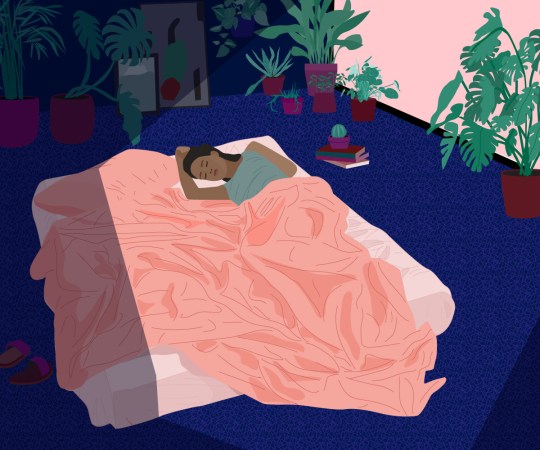We may earn revenue from the products available on this page and participate in affiliate programs.
My struggles with sleep began around the same time my anxiety levels started to spike, shortly after moving cities for a fancy new job. I lay in bed night after night, squeezing my eyes shut as I tried to reason with my racing brain that I needed to fall asleep. I became increasingly anxious as I worried about the fact that, in spite of my efforts, I just couldn’t sleep.
I distracted myself from the distress of being awake by diving deep into Wikipedia black holes and streaming my favorite shows. When the weekend came around, my sleep-deprived body would beg for extra hours in bed, desperate to catch up on the shut-eye that eluded me during the week. With my sleep health at an all-time low, I was desperate for help. Following the advice of multiple doctors, I went on a short-term regimen of sleep medication. I slept but woke up feeling even drowsier and more tired than before.
The booming sleep industry, with its promises emblazoned across subway and social media advertisements, convinced me that I needed new pillows, mattresses, blankets, sleepwear, eye masks, aromatherapy sprays, and herbal supplements to improve the quality of my shut-eye. I bought into it all until I realized that my sleep became unhealthily dependent on the product du jour that I was trialing.
The end of my negative sleep spiral began under the guidance of breathwork and yoga master Max Strom, who showed me the potential of conscious breathing during the 200 hours of interdisciplinary training I undertook with him in London. While certain transformative breathing exercises led to powerful emotional release, I became drawn to the sense of peace that permeated throughout my mind and body after the daily repetition of simple, meditative breath patterns. Before the summer was out, I began sleeping, and sleeping well, once again.
Many remain unaware that one of the most powerful tools for bettering our sleep is one we already have: our own breath. “Breathing is the only system in the body that is both automatic and also under our control,” explains leading breathwork practitioner Richie Bostock. When our Autonomic Nervous System (ANS), which regulates many of our unconscious bodily functions such as heart rate, rate of breathing, and digestion, goes into what is commonly known as fight-or-flight mode in response to a perceived threat, we can calm it down from a state of high arousal to one of rest and relaxation by consciously regulating our breath.
Developed as an essential mechanism for survival when humans were hunter-gatherers, the fight-or-flight response from our ANS has not yet evolved to deal with the new stressors that we manage on a day-to-day basis, including worrying about career, finances, relationships, and more (Did you turn the stove off? Did you water your houseplant?) as well as being inundated by notifications on various devices from friends, colleagues, and the 24-hour news cycle.
“Today’s constant and daily stressors lead to continual activation of the stress response,” says yoga therapist Lisa Sanfilippo. In her book Yoga Therapy for Insomnia and Sleep Recovery, she explains: “In these situations, summoning energy and capabilities to take physical action isn’t what’s required, so we’re left feeling fearful and hyper-aroused.” Breath practices, gentle yoga postures, and mindful meditation can all become sustainable ways to manage stress that you can use at any time—even when seemingly nothing helps you fall asleep.
Take a deep breath
Try one or all of the breathing exercises below as part of your nighttime routine, which can be done while sitting in an upright position or lying down in bed. Check that your spine is in its neutral S shape, with your ears, shoulders, and hips lined up vertically (sat up) or horizontally (in bed) to allow your body to breathe optimally.
The 3-4 Breath
This is a simple breathing exercise designed to lengthen your exhale and slow the heart rate. Sanfilippo recommends the 3-4 breath for anyone brand-new to breathwork, as well those who may have difficulty holding their breath.
Starting with empty lungs, breathe into your belly through your nose for a count of three. Then exhale through your nose for a count of four. Start with a few rounds of this breath. With time, increase the number of rounds as well as the time spent on each count, keeping the 3:4 ratio.
The Box Breath
Used by everyone from C-suite executives to Navy SEALs, this four-part breathing exercise is great for focusing the mind while calming the ANS. The breath is broken down into four equal parts—inhale, hold, exhale, hold—like the sides of a square. Bostock suggests starting with five seconds per side, making the lengths shorter or longer as necessary.
Starting with empty lungs, breathe into your belly through your nose for a count of five. Hold your breath for a count of five. Then exhale through your nose for a count of five and again, hold your breath for a count of five. Repeat this pattern for a few minutes. Vary the lengths of each phase depending on what feels comfortable to you; this is likely to change as you practice more.
The Mind Meets the Breath
This exercise from Strom is partly inspired by the tradition of zen meditation. By observing the breath as well as controlling it at a slow and steady rhythm, it encourages quiet mental focus while activating the rest response in the ANS.
Following a natural exhale, breathe in slowly and evenly through your nose until your lungs and belly feel full. Without pausing, breathe out slowly and evenly through your nose. Continue to breathe in this way, counting the number of breath cycles you go through in three minutes. Make a note of this number, and notice if this changes as you practice the exercise.
See more wellness:
6 Ways I Restyled My Home to Soothe Anxiety What Actually Happens to Your Body When You Meditate These Supplements Are Guaranteed to Improve Your Mood












